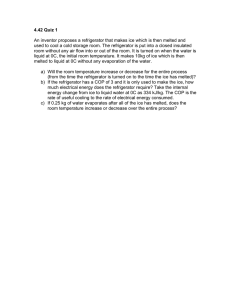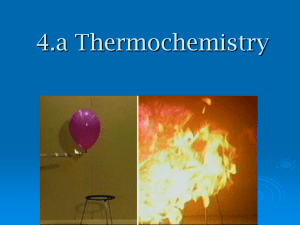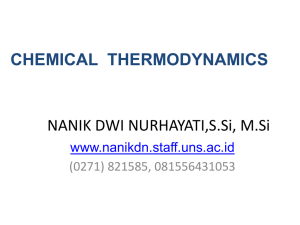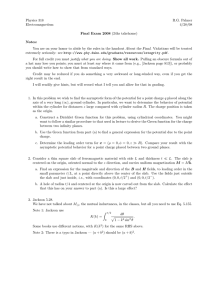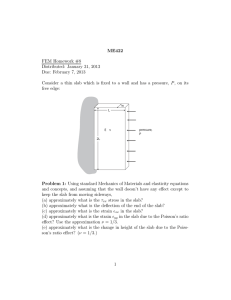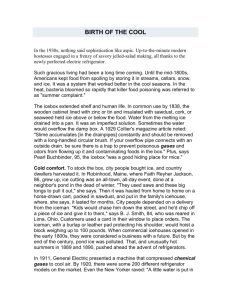4.42 Quiz 1 Solutions
advertisement
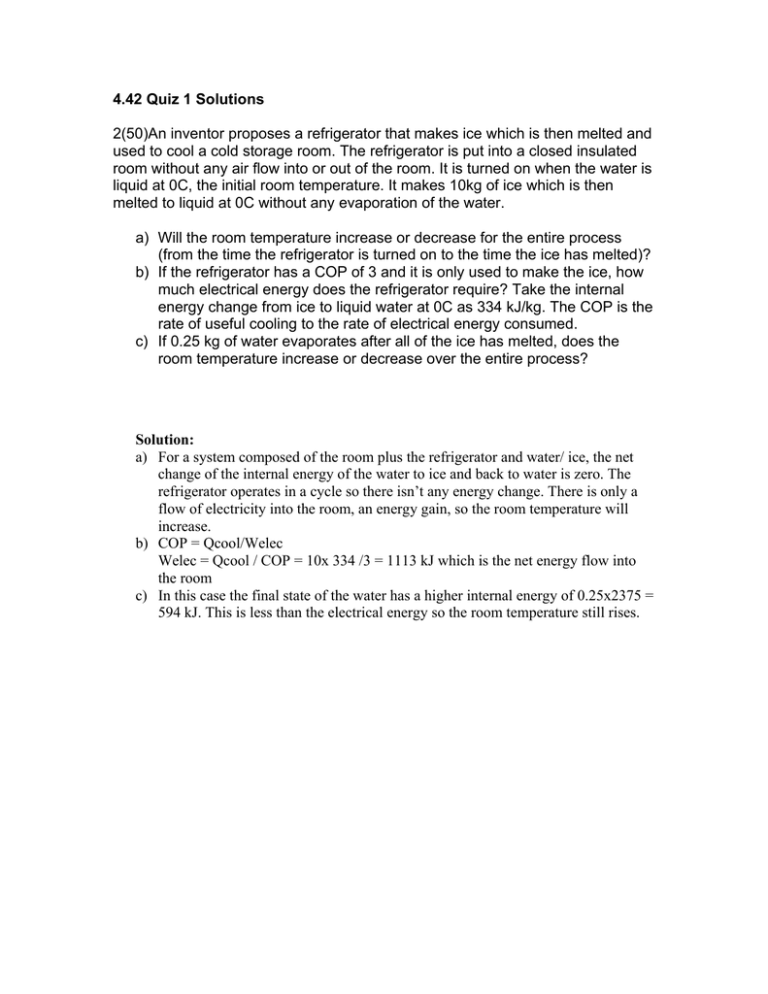
4.42 Quiz 1 Solutions 2(50)An inventor proposes a refrigerator that makes ice which is then melted and used to cool a cold storage room. The refrigerator is put into a closed insulated room without any air flow into or out of the room. It is turned on when the water is liquid at 0C, the initial room temperature. It makes 10kg of ice which is then melted to liquid at 0C without any evaporation of the water. a) Will the room temperature increase or decrease for the entire process (from the time the refrigerator is turned on to the time the ice has melted)? b) If the refrigerator has a COP of 3 and it is only used to make the ice, how much electrical energy does the refrigerator require? Take the internal energy change from ice to liquid water at 0C as 334 kJ/kg. The COP is the rate of useful cooling to the rate of electrical energy consumed. c) If 0.25 kg of water evaporates after all of the ice has melted, does the room temperature increase or decrease over the entire process? Solution: a) For a system composed of the room plus the refrigerator and water/ ice, the net change of the internal energy of the water to ice and back to water is zero. The refrigerator operates in a cycle so there isn’t any energy change. There is only a flow of electricity into the room, an energy gain, so the room temperature will increase. b) COP = Qcool/Welec Welec = Qcool / COP = 10x 334 /3 = 1113 kJ which is the net energy flow into the room c) In this case the final state of the water has a higher internal energy of 0.25x2375 = 594 kJ. This is less than the electrical energy so the room temperature still rises. An MIT fraternity holds a party in their largest common room, which is 10m long x 10m wide x 3m high. The party lasts 4 hours and 300 students attend. Because everyone is dancing, each person gives off 300 Btu/hr of sensible heat. The home theatre system uses 1000W. Two 100W lights are also on. The room has a 0.1m concrete slab floor. The air in the space and the slab are initially at 68 ºF. Assume that the specific humidity remains constant for both problems. a. If the room is perfectly insulated and there is no ventilation system, what is the temperature of the air in the space at the end of the party? Assume that the air and floor slab end up at the same temperature and that all electrical equipment is on the whole time. Is this a comfortable temperature? b. For their second party, the frat brothers decide to naturally ventilate the space using two windows, each 1.5m x 2m. The temperature of the air outside is 60 ºF and the wind velocity is 2 m/s. Let vin be the velocity of air entering the open windows. Assume that vin = 0.35 vwind and that all the rate of air leaving the space is the same as air entering the same. If all other conditions stay the same, what is the temperature of the air in the space at the end of the second party? Again assume that the air and floor slab end up at the same temperature and that all air is well-mixed. Is this a comfortable temperature? Solution: a. First find the total amount of heat gain in the room: Qpeople = 300 people * 300 Btu/hr * 1055 J/Btu * 4 hrs = 3.8 x 108 J Qequipment = (1000 W + 200 W) * 4 hrs * 3600 s/hr = 1.7 x 107 J Qtotal = Qpeople + Qequipment = 3.97 x 108 J To find Tfinal, we use the energy conservation equation: ∆Uair + ∆Uslab = cair mair ∆T + cslab mslab ∆T = Qtotal We have seen from previous problems that in this situation we can assume that ∆Uair will be negligible, so we will only consider ∆Uslab. We know that cslab = 880 J/kg-ºK, ρslab = 2100 kg/m3, and Vslab = 100 m2 x 0.1 m = 10 m3 Plugging these into the energy conservation equation, we find: cslab mslab ∆T = Qtotal 880 J/kg-ºK * 2100 kg/m3 * 10 m3 * ∆T = 3.97 x 108 J ∆T = 21.5 ºC ∆T = Tfinal – 20 ºC Æ Tfinal = 41.5 ºC or 106.7 ºF !!! Clearly, this is not a comfortable temperature for the party. b. We know that the total amount of heat gain in the room will be the same as in part a. For this problem, it is easier to use the rate of heat gain in W: dQtotal/dt = 3.97 x 108 J / (4hrs * 3600 s/hr) = 27575 W We can also find the rate of internal energy change in the slab: dUslab/dt = (880 J/kg-ºK*2100 kg/m3*10 m3*∆T) / (4hrs*3600 s/hr) = 1283*∆T W Now find the mass flow rate of the air: = ρ v = 0.35*ρ * vwind*Awindow = 0.35*(1.22 kg/m3 )*(2 m/s)*(6m 2 ) = 5.12 kg/s m Consider the energy conservation equation with the addition of moving air into the space: +U slab + m inhin - m inhout = 0 ∆E = Q Since we know that the rate of air entering the space is equal to that leaving, we can simplify to: +U +m slab + m(h in - hout) = Q slab * cslab * ∆Tslab + m air * cair * ∆Tair = 0 ∆E = Q =m slab * cslab *(Tfinal - Tinitial) + m air * cair * (Tfinal - Tinitial) Q Plugging everything in, we solve: 27575 W = 1283 W/ºK*( Tfinal – 20 ºC) + (5.12 kg/s)*(700 J/kg-ºK)*( Tfinal – 15.5 ºC) Tfinal = 22.3 ºC or 72.1 ºF This is clearly a much more comfortable temperature for the party. MIT OpenCourseWare http://ocw.mit.edu 4.42J / 1.044J / 2.45J Fundamentals of Energy in Buildings Fall 2010 For information about citing these materials or our Terms of Use, visit: http://ocw.mit.edu/terms.
